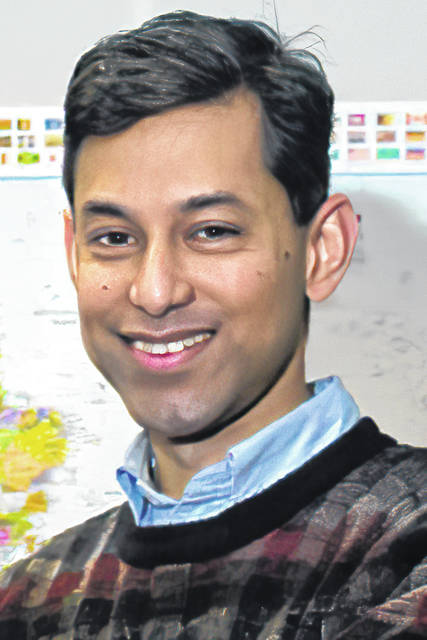
The impact of COVID-19 on economics was discussed by an Ohio Wesleyan University professor in a virtual class given last week.
“International and Global Economic Aspects of COVID-19: Where Are We, and Where Do We Go?” was the topic of a lecture by Saif Rahman (Economics) on June 17.
“This crisis is unlike anything we’ve seen in the last 100 years (the Spanish Flu pandemic of 1918), even the Great Depression. It’s much deeper and harder,” Rahman said. The coronavirus pandemic is different, he said, because the virus is not in our control, it is affecting most of society in terms of being in an recession, it requires “second responders” like ourselves to stringently practice social distancing and good hygiene to mitigate the spread, and it is hurting both the supply-side and demand-side of the economy simultaneously.
He said that “minority populations in our societies bear disproportionate amounts of the burden from the dual crisis of COVID-19 and economic contraction.”
Rahman noted that during the recession of the last decade, there were different recovery paths, as measured by Gross Domestic Product. Canada’s recovery was the shape of a V on the chart, the United States was a U-shape, and Greece had a more prolonged L-shape.
A forecast from the International Monetary Fund for the remainder of the year shows a lack of GDP growth in Australia, Europe, Russia, North and South America; while there are slight gains in parts of Africa and Asia. Other charts from the IMF and World Bank showed the steep decline in GDP growth, which is more pronounced in advanced economies as opposed to developing economies.
In a series of graphs, Rahman showed that the dramatic increase in unemployment claims due to the current pandemic represented an “unprecedented shock to the system in the U.S.” The monetary policy of liquidity support from central banks is currently loosening borrowing rates in many countries. In addition, the “stock market is often not a great reflection of the real economy, nor of broad socioeconomic conditions.”
He also noted that trade diminishes greatly during recessions. Also, countries that are primarily commodity exporters generally have more cases of COVID-19 than nations who are commodity importers.
While the U.S. has more coronavirus cases, deaths and recoveries than any other nation, its healthcare capacity in terms of number of workers and hospital beds is better than many emerging and developing nations that are now experiencing a surge in cases. However, the U.S. still has what Rahman called a “dysfunctional” healthcare system. It is a major task, but it can be fixed, he said.
“Imagine as we (the U.S.) struggle, and then them (developing nations) with half of that capacity and low incomes,” Rahman said.
On a global level, he added, “By 2021, COVID-19 may cause about 100-140 million people to fall into extreme poverty.”
Rahman said extreme poverty means having only a couple dollars per day to spend. Vulnerable populations are experiencing poverty on different levels. The “impact on the poor is most likely to be hardest in South Asia and in sub-Saharan Africa … and projections are getting worse.”
Support is critical in managing this crisis, from sources such as community networks and non-governmental organizations, public sector safety nets financed by government, and international assistance. Many nations lack two of those three sources, Rahman said.
“I’m in touch with people in several countries, and the news is not good. Things are worsening, and people are dying. They’re doing the best they can. It’s not about going to a restaurant, it’s about life and death,” he said.
Rahman pointed to Peru, a nation in South America that had a great plan for dealing with the crisis, but structural inequality has led to major problems. Rahman said that Mumbai in India is also experiencing problems; but in the province of Kerala, the female health minister’s measures have resulted in only 20 deaths from a population of 35 million.
“Managing an unprecedented dual crisis and limiting the human suffering is possible,” Rahman said near the end of the hour-long class. “Crisis management requires relevant infrastructure in place, timely mitigation efforts, support for vulnerable groups, transparent communication, proper supplies, public-private partnerships and leadership.”
He wondered, once the world navigates past the COVID-19 crisis, will nations “emerge in a more cooperative and open global society, or will the momentum of populist nationalism bring greater isolation?” He also wondered if “humanity and goodness” could help the minority populations.
In response to viewer questions, Rahman said that if he could advise politicians, he would tell them to ask people what is really important to them. In addition, we should not be politicizing whether we should be wearing masks or when we should be opening back up, he said.
“I never thought I’d live through the type of history we are witnessing today,” Rahman said. “It’s not about economics, it’s about people, and I want to try and help in showing how COVID is affecting people’s lives.”
His presentation ended with a quote from Nelson Mandela: “A nation should not be judged by how it treats its highest citizens, but its lowest ones.”
Course moderator Kira Bailey said this 16th virtual class concluded week eight of a 10-week, free online course called “We’re in This Together: An Interdisciplinary Exploration of the Coronavirus Pandemic.” Taught by 24 Ohio Wesleyan faculty members, the course is open to students and the public alike.
OWU spokespersons have said more 1,200 people are participating in the class, and more than 350 people are taking part in a Facebook COVID-19 Class Discussion Group.
For more information about OWU’s “We’re in This Together” course, visit www.owu.edu/COVIDclass.


